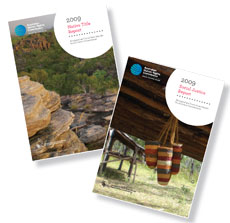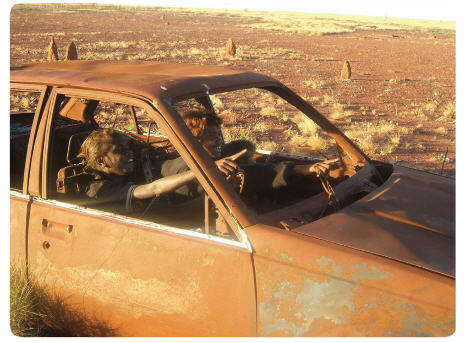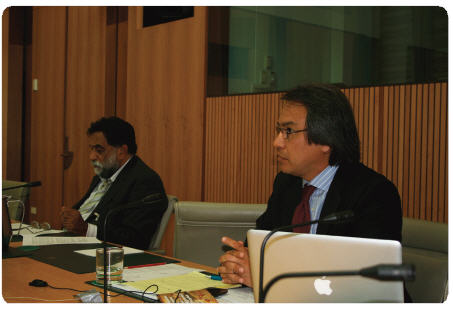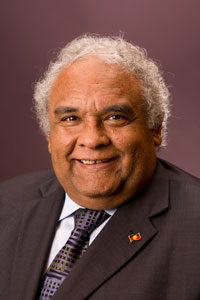A Community Guide to the 2009 Social Justice and Native Title Reports
 2009 Social Justice and Native Title
2009 Social Justice and Native Title
Reports
A Community Guide
- Download Community Guide in
 PDF |
PDF |  Word
Word
- A Note from the Commissioner
- Justice Reinvestment: a new solution to the problem of Indigenous over-representation in the criminal justice system
- Respecting Indigenous land ownership
- Indigenous Languages: critically endangered
- Sustaining Aboriginal homeland communities
- The state of land rights and native title policy in Australia: Promising first steps towards change
- Realising the potential of native title: Towards a just and equitable system
- Human Rights: Case Studies on homelands and education
- More on Social Justice and Native Title
Please be aware that this publication may contain the names or images of
Aboriginal and Torres Strait Islander people who may now be
deceased.
Reports
A Note from the Commissioner
In my role as Aboriginal and Torres Strait Islander Social Justice
Commissioner, I produce two annual reports on Aboriginal and Torres Strait
Islander peoples’ human rights issues – the Social Justice
Report and the Native Title Report.
The reports, which are tabled in federal Parliament, analyse the major
changes and challenges in Indigenous affairs over the past year. They also
include recommendations to government that promote and protect the rights of
Aboriginal and Torres Strait Islander peoples.
This Community Guide gives a brief overview of some of the key issues in both
reports for 2009.
In this year’s Social Justice Report I focus
on three areas: justice reinvestment to reduce Indigenous over-representation in
the criminal justice system; protection of Indigenous languages; and sustaining
Aboriginal homeland communities.
At their core these issues speak to the need for strong communities. This
might be through reinvesting money in crime prevention and keeping people out of
prison; protecting language and culture that is the glue which keeps communities
together; or supporting strong homelands as a model of community development and
self-determination.
Our communities are not just where we come from, but who we are. They
represent our family connections, proud history and rich culture. I hope that
they remain strong and can in turn sustain future generations. My final Social Justice Report provides some new ideas and recommendations to do
this.
In this year’s Native Title Report, I review important
developments in native title law and policy that occurred during 2008-2009.
During this time, the Australian Government pursued its commitment to improving
the operation of the native title system.
I also consider further legislative and policy options for creating a just
and equitable native title system.
Finally, I provide an update on Indigenous land tenure reform across
Australia. I then set out principles that governments should follow when
implementing such reforms.
Justice Reinvestment: a new solution to the problem of Indigenous
over-representation in the criminal justice system
Indigenous over-representation in the criminal justice system is a
significant social justice issue that needs urgent attention. Some worthy
initiatives have been developed since the Royal Commission into Aboriginal
Deaths in Custody in 1991. However, what we are doing is simply not working.
Justice reinvestment is a localised criminal justice policy approach, that
first emerged in the United States. Under this approach, a portion of the public
funds that would have been spent on covering the costs of imprisonment are
diverted to local communities that have a high concentration of offenders. The
money is invested in community programs, services and activities that are aimed
at addressing the underlying causes of crime in those communities.
Justice reinvestment still retains prison as a measure for dangerous and
serious offenders. However, justice reinvestment actively shifts the focus away
from imprisonment to the provision of community-wide services that prevent
offending. Justice reinvestment is not just about reforming the criminal justice
system – it is about trying to prevent people from getting involved in the
system in the first place.
Justice reinvestment is as much about economics as it is about good social
policy. Justice reinvestment asks the question: is imprisonment good value for
money? In Australia, we spend increasing amounts on imprisonment, yet prisoners
are not being rehabilitated, and rates of return to prison are high. This is a
particular problem among Aboriginal and Torres Strait Islander communities.
Indigenous imprisonment rates in Australia are unacceptably
high
- Nationally, Indigenous adults are 13 times more likely to be imprisoned than
non-Indigenous adults. - Indigenous juveniles are 28 times more likely to be placed in juvenile
detention than their non-Indigenous counterparts.
There is a
lot we can learn from justice reinvestment policies in the United States, and
emerging interest in this approach in the United Kingdom. I consider these
examples in this year’s Social Justice Report.
Justice Reinvestment: A success story
Imprisonment rates are dropping in places where justice reinvestment is being
implemented. For example, there was a 72% drop in juvenile incarceration in
Oregon, USA, after money was reinvested in well-resourced restorative justice
and community service programs for juvenile offenders.
We need to be bold and creative to shape better solutions to Indigenous
offending. That is why in this year’s Social Justice Report I look
to justice reinvestment as a new approach that may hold the key to unlocking
Indigenous Australians from the cycle of crime and increasing imprisonment
rates.

Left to Right: Jeanette Gordon, Mona Sunfly,
Danika Kingsley (toddler) of the Kukutja people in Balgo, Western Australia.
This photo was taken during a program with local youth who have come out of
incarceration, under the Kutjungka Documentation Project. Photo: Azaria
Rogers (2008)
Respecting Indigenous land ownership
During 2008-2009, Australian governments continued to develop policies and
implement new laws in relation to Indigenous land.
One of the most important developments is that the Australian Government has
linked the provision of funding for essential services to government control
over Indigenous land. Many Indigenous communities desperately need funding for
housing. In order for some communities to be eligible for housing funding,
Indigenous land owners are required to provide a lease or sublease of at least
40 years to the Australian Government.
I am concerned about these policies and the way they impact on Indigenous
people across Australia. Governments have referred to these reforms as a way of
promoting home ownership and economic development, but this can be misleading. I
am also concerned that the Australian Government has not presented these
policies in a clear and transparent way.
The Australian Government has also retained measures that were introduced as
part of the Northern Territory Emergency Response (also known as the
‘Intervention’). During 2008-2009, the Government threatened to use
these powers to compulsorily acquire town camp land in Alice Springs.
These reforms, and continuing policies, provide governments with control over
the land. Aboriginal and Torres Strait Islander peoples have fought hard for
their rights over their lands to be recognised. Shifting control of land from
communities to the government creates a barrier to self-governance. It can also
further marginalise Indigenous communities.
Aboriginal and Torres Strait Islander peoples have legitimate concerns about
losing control over decision-making in their own communities. In this
year’s Native Title Report I call on governments to consider
different approaches to Indigenous land reform, and recommend that the
Australian Government end compulsory five-year leases.
Governments should focus on providing improved forms of land ownership to
Aboriginal and Torres Strait Islander peoples.
|
[G]overnment initiatives to address the housing needs of indigenous peoples, should avoid imposing leasing or other arrangements that would undermine indigenous peoples’ control over their lands. Professor S James Anaya, UN Special Rapporteur on the
situation of human rights and fundamental freedoms of indigenous people |

Right to Left: Professor S James Anaya (UN Special
Rapporteur) and Les Malezer (Foundation for Aboriginal and Islander Research
Action) at a public forum hosted by the Indigenous Peoples’ Organisations
Network of Australia and the Australian Human Rights Commission on 3 December
2008. Photo: Julia Mansour (2008)
A principled approach
In the Native Title Report 2009 I identify the Australian
Government’s approach to land tenure reform. I also highlight developments
in land tenure reform in the Northern Territory, Queensland, New South Wales,
South Australia and Western Australia.
I set out principles that should underpin the introduction of any land
tenure reforms or home ownership schemes. This includes providing the community
with clear and appropriate information. Respect for the free, prior and informed
consent of Indigenous peoples is at the centre of these principles.
Indigenous Languages: critically endangered
Indigenous languages are critically endangered in Australia. They continue to
die out at a rapid rate. Prior to colonisation, Australia had 250 distinct
languages, which could be subdivided into 600 dialects. Today, Australia has 100
Indigenous languages, though most of them are in varying stages of extinction.
There are only 18 Indigenous languages that are currently spoken by all people
in all age groups across a given Indigenous language group. Without
intervention, it is estimated that Indigenous language usage will cease in the
next 10 to 30 years.
The loss of Indigenous languages in Australia is a loss for all Australians.
Cultural knowledge is carried through languages, so the loss of language means
the loss of culture. This in turn has the potential to impact on the health and
well-being of Indigenous peoples. Significant research shows that strong culture
and identity assists us to develop resilience.
Up until the 1970s, Australian government policies and practices banned and
discouraged Aboriginal and Torres Strait Islander peoples from speaking our
languages. Many of those who were forcibly taken to hostels and missions lost
their languages due to the prohibitionist polices and practices of governments
and churches.
languages
Australian governments should act to preserve and promote Indigenous
languages because:
- Evidence shows improved cognitive functioning in children who are
bilingual - Minority groups who speak their languages and practice their culture, enjoy
better social, emotional and health outcomes than groups who do not - Cultural knowledge has been proven to assist in the employment of Indigenous
people in Australia - There are economic and social costs associated with the loss of
languages - Indigenous languages have intrinsic value to the people who speak
them.

 Tom Calma is the Aboriginal and Torres Strait Islander Social Justice
Tom Calma is the Aboriginal and Torres Strait Islander Social Justice